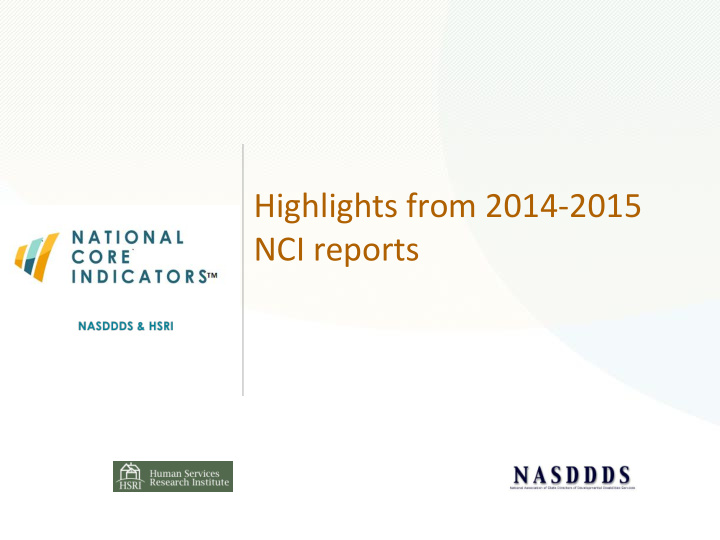



Highlights from 2014-2015 NCI reports
How States Examine NCI Results: National and State Reports
User-Friendly Reports National Core Indicators (NCI)
Data Briefs and Webinars National Core Indicators (NCI)
NCI Blog The NCI blog connects NCI data to current events, articles and other topical themes. Always looking for guest posts and topic suggestions. Email Dorothy at dhiersteiner@hsri.org http://www.nationalcoreindi cators.org/blog/articles National Core Indicators (NCI)
NCI Chart Generator 1) Choose www.nationalcoreindicators.org/charts/ Measure/Outcome 2) Choose Year 4)Generate Chart 3) Choose state or NCI Average National Core Indicators (NCI)
Selected Findings ACS Of those with paid community job, individuals living independently were more likely to have chosen their job. Similarly, also more likely to have some input in choosing day activity. Individuals living independently More likely to have gone • shopping in past month. Less likely to have gone out • for entertainment National Core Indicators (NCI)
Selected Findings Family Surveys National Core Indicators (NCI)
Respondents under 75 (N= Aging Caregivers: AFS 4,567) Respondents 75 and older (N= 546) What Other Services Total N: 5,113 Are Needed Crisis or emergency 83% services were provided when needed** Need help for 68% (in the past year) development of long term care. His care provider Better and father is 76 transportation . We need more years old. Has He misses a lot of respite . We are tried to get help 31% work due to glad to have what Other services are from state transportation we have. needed** advisor to plan problems. 40% for his care upon death of his father. 0% 20% 40% 60% 80%100% Under 75 75 and older (selected comments from those 75 and older)
Care provider over 75: Less choice of both agencies and support workers. Provider and Staff Choice 100% 80% 65% 56% 60% 49% 42% 40% 20% 0% Respondent or other family Respondent or other family always chooses provider agencies always chooses support workers Under 75 75 and older
Staff Stability 2014 • 10 participating states 2014: 2015: AZ AL DC AZ • 793 responses GA DC KY GA 77% provide residential ME IN supports OH KY SC MN 59% provide in-home TX MO UT OH 76% provide non VT OR residential PA SC SD TN TX UT VT
Tenure: Separated DSPs Percent of DSPs # of employed less than 12 DSPs months before Separat Less than 6 Months of 6-12 Months of ed Tenure Tenure separation More Than 12 Months of Tenure AZ 2836 43.9% 30.0% 25.4% 73.9% N* 37 28 27 24 DC 465 31.0% 29.3% 43.2% 60.3% N* 25 16 17 17 GA 943 38.8% 20.3% 42.8% 59.1% N* 41 27 27 29 KY 2773 42.0% 22.9% 38.4% 64.9% N* 146 103 99 99 ME 524 29.5% 14.8% 55.9% 44.3% N* 15 13 12 13 OH 9706 32.6% 20.3% 42.8% 52.9% N* 281 166 144 170 SC 778 26.3% 25.2% 49.2% 51.5% N* 15 13 11 11 TX 1940 49.8% 19.0% 33.5% 68.8% N* 47 31 29 30 UT 2533 48.5% 24.3% 27.7% 72.8% N* 28 18 18 20 VT 500 29.5% 15.6% 55.5% 45.1% N* 15 14 14 13 TOTAL 22998 AVERAGE: 37.2% 22.2% 41.4% 59.4%
Wages • Across all participating states and service types, DSPs received an average hourly wage of $11.11. $10.55 for DSPs providing residential supports. $10.93 for DSPs providing in-home supports. $11.10 for DSPs providing non-residential supports. • Broken out by organization type, average hourly wages were higher for DSPs working at public/government provider agencies than for those working at private, for-profit and private, non-profit agencies.
Recommend
More recommend